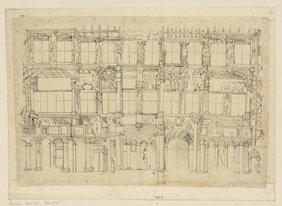The design for a facade painting, which at the first glance seems somewhat confusing, is one of the oldest dated drawings in the collection. The draftsman of the sheet has entered the year of origin, 1525, barely visible on a tablet that holds up the figure on the second floor in the center axis of the rightmost window. Although the sheet was well known in art historical research and, moreover, can be ranked among the oldest surviving designs for a facade painting north of the Alps, the evaluation of the sheet seemed strangely reserved. Thus, even from the context of the collection's history, it is no longer possible to identify exactly by whom the attribution to the Basel artist Urs Graf the Elder (c. 1485-1528) originated. Albrecht Haupt himself classified the sheet as the work of an unknown Basel master in the "manner of Holbein" and counted it among the most valuable sheets in his collection of drawings.
The strong spatiality of the illusionistic architectural painting and the pleasure in the tricky use of perspective cannot be explained without the model of Hans Holbein the Younger's designs for the "Haus zum Tanz" in Basel, created in the early 1520s. It is therefore logical to assume that an artist from Holbein's local environment was responsible for the design. The way the sketched figures are depicted points to Urs Graf the Elder, who was particularly known for his coarse, sensual scenes.
As far as we know, an exact assignment to the stately three-story townhouse for which the design was specifically intended has not yet been made. What is striking is the width of the front facade, which had ten, probably partly painted window axes. The deciphering of the picture program could bring clarification, which shows in the upper row some allegoric figures.
sp

